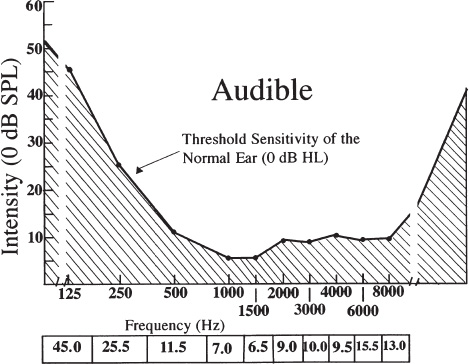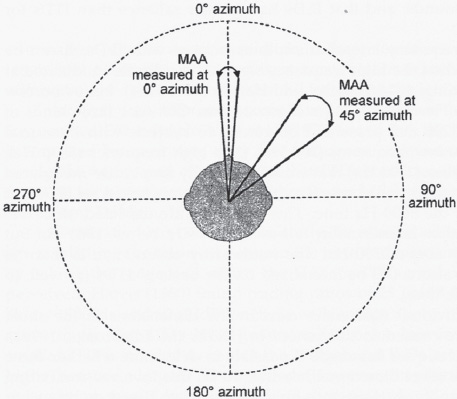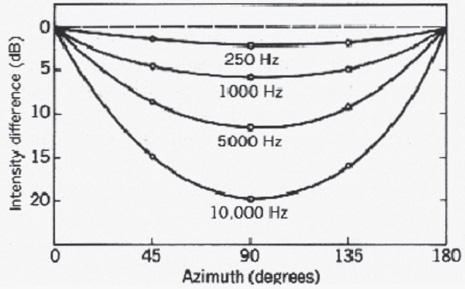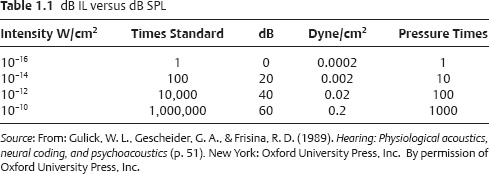1 Psychoacoustics The decibel (dB) is a logarithmic unit of measurement used to express the magnitude of a sound relative to some reference level. Decibels in hearing level, or dB HL, is commonly used in audiology because it refers to the decibel level on the audiometer. The reference level for dB HL is “10,” which is related to the average threshold in decibels sound pressure level (dB SPL) for the average, normal-hearing listener. In Fig. 1.1, the solid black line represents the average auditory threshold in dB SPL at each audiometric frequency. Each threshold in dB SPL, which is noted in the table at the bottom of Fig. 1.1 , is equal to 0 dB HL on the audiometer for the corresponding frequency. Decibels in sound pressure level, or dB SPL , refers to the magnitude of the displacement of molecules in the air. The reference for dB SPL is 20 micropascals (20 μPa) or 0.0002 dynes/cm2. Because it is easy to measure dB SPL with a condenser or free-field microphone coupled to a sound level meter, sound measurements are often expressed in dB SPL. As stated in the previous section, a common method to express the magnitude of a sound is in decibels sound pressure level or dB SPL, for which the reference is 0.0002 dynes/cm2. A less common method to express sound intensity is in acoustic power by using decibels intensity level, or dB IL. The reference for dB IL is 10–16 W/cm2. According to Gulick, Gescheider, and Frisina (1989), “a dangerously intense sound would represent a power of only about 0.0024 watt” (p. 46). As a result, it is cumbersome to measure the incredibly small amounts of power associated with the enormous range of intensities that the human ear can hear. Note in Table 1.1 that the dB values are the same regardless of whether they were calculated from intensity (power) or pressure; however, a 100-fold increase in intensity is equal to a 10-fold increase in pressure. Fig. 1.1 Average thresholds across frequency in dB SPL, corresponding to 0 dB HL. For example, at 125 Hz: 0 dB HL = 45 dB SPL, and at 1000 Hz: 0 dB HL = 7 dB SPL. (From: Roeser, R. J., & Clark, J. L. (2007). Pure-tone tests. In R. J. Roeser, M. Valente, & H. Hosford-Dunn (Eds.). Audiology: Diagnosis. 2nd ed. (pp. 238–260). New York: Thieme Medical Publishers, Inc.) Detection is simply the ability to determine if a sound is present or absent, whereas discrimination is the ability to determine the difference between two stimuli or sounds. For example, during speech audiometry patients are asked to repeat spondee words (e.g., mushroom, baseball) until a speech recognition threshold (SRT) is established. In this case, the words are increased and decreased in 5 dB steps until the audiologist finds the softest level in dB HL at which the patient can correctly repeat the word 50% of the time (hence the term speech recognition threshold). Sometimes, an SRT cannot be measured and the audiologist is simply interested in measuring the level (dB HL) where the patient is aware that speech is present (speech awareness threshold, or SAT). Therefore, the SAT is a detection measure, whereas the SRT is a threshold measure. Also, it should be clear that the dB HL associated with the SAT is lower than the dB HL associated with the SRT because one is a detection measure, whereas the other is a threshold measure. Another common measure used by audiologists is the word recognition score (WRS). The WRS is a speech discrimination measure in which the patient repeats a list of 50 common, one syllable (monosyllabic) words. The words are presented at a dB level at which the listener can hear clearly, which for most normal-hearing listeners is ~40 dB louder than the listener’s SRT (i.e., 40 dB SL or sensation level). The WRS is a percentage correct score (from 0 to 100%) and is useful in differential diagnosis and counseling. The minimum audible angle (MAA) is the smallest change in the location (azimuth) of two sound sources that can be perceived by a listener. The MAA is smallest (the listener can best identify small changes in azimuth) when the sound sources are in front of the listener (0° azimuth), and is largest (poorer) when the sound sources are to the side of the listener. When sounds are directly in front of the listener, very small changes (1–2° azimuth) result in an increased ability to make use of interaural differences (Gelfand, 2004); whereas when two sound sources are to the side of the listener, interaural differences remain very similar with changes in angle. Figure 1.2 illustrates the differences in MAA for sounds originating at 0° and 45° azimuth. Fig. 1.2 The MAA is smallest for sounds originating directly in front of the listener, or at 0° azimuth, and is largest when the sound sources are to one side of the listener. (From: Gelfand, S. A. (2004). Hearing: An introduction to psychological and physiological acoustics. 4th ed. New York: Marcel Dekker.) One of the major advantages of binaural listening is sound localization. differences in the arrival time and intensity of a sound between the two ears are used to determine a sound’s location in space. Interaural level difference (ILD), which refers to the difference in the intensity of a sound at the two ears, is used in the localization of high-frequency sounds (primarily above 2800 Hz). High-frequency sounds have wavelengths shorter than the circumference of the head, and are thus influenced by the head shadow effect. In other words, a high-frequency sound originating to the right of a listener will decrease in intensity at the center ear due to the “roadblock” the high-frequency sound encounters at the head. In addition, spectral differences (i.e., interaural spectral differences) exist between the two ears, especially for high-frequency sounds, as spectral information is lost due to the defl ection and attenuation caused by the head shadow effect. Figure 1.3 illustrates the difference in ILD for pure tones at various frequencies and azimuths. As can be seen from Fig. 1.3, the difference in intensity between the two ears at 10,000 Hz is ~20 dB when presented at 90°; however, these differences lessen as the azimuth of the signal is greater than or less than 90°. Also, note that as frequency decreases, the ILD decreases from 20 dB at 10,000 Hz to less than 5 dB at 250 Hz. Interaural time difference (ITD) refers to the difference in the time it takes for a sound to reach each ear after the onset of a sound. Sound localization using ITDs as cues is best for low-frequency sounds
 What Is the Difference between dB HL and dB SPL?
What Is the Difference between dB HL and dB SPL?
 What Is the Difference between dB IL and dB SPL?
What Is the Difference between dB IL and dB SPL?

 What Is the Difference between Detection and Discrimination?
What Is the Difference between Detection and Discrimination?
 What Is the Minimum Audible Angle?
What Is the Minimum Audible Angle?

 What Psychoacoustic Properties Influence Sound Localization?
What Psychoacoustic Properties Influence Sound Localization?

![]()
Stay updated, free articles. Join our Telegram channel

Full access? Get Clinical Tree



